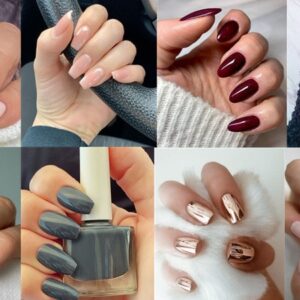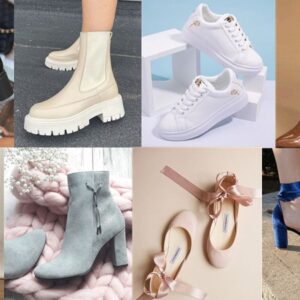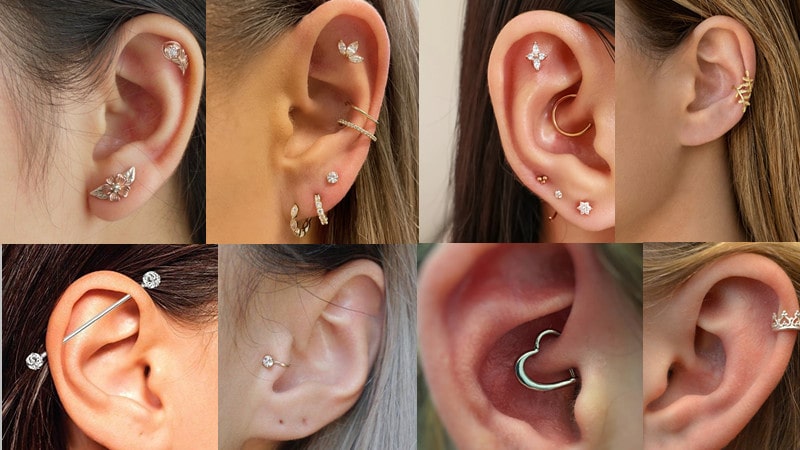
Ear piercings are among the most popular forms of body art, especially because of their limitless possibilities in self-expression. They offer you a unique, sophisticated, and permanent way to make a fashion statement.
New and more sophisticated types of ear piercings are being developed every day to match the new fashion trends. This article offers you the 8 cool-girl types of ear piercings you should try.
How to Prepare for Ear Piercings
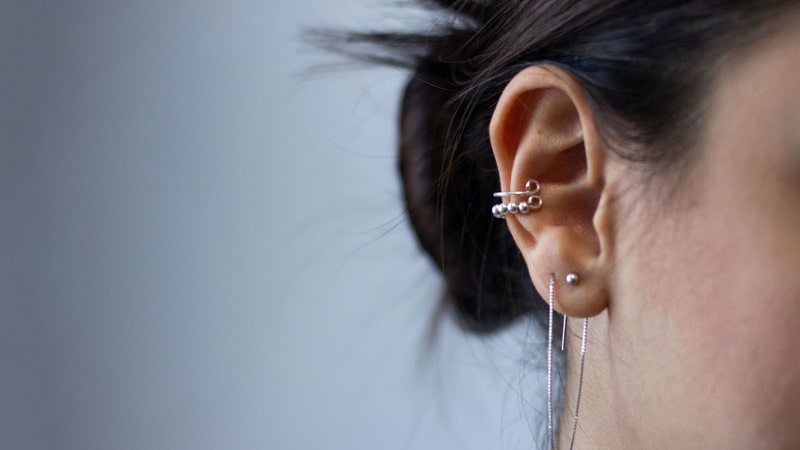
Whether you want the traditional earlobe piercing or something more exotic, there are several important steps you need to take when preparing to get an ear piercing.
It’s also important to have enough facts about the whole process and what to expect before you book an appointment with your ear designer. Here are some important tips on how to prepare for ear piercings.
1. Find the Best Ear Designer
The success or failure of the whole process of getting your ears pierced depends on the kind of ear designer you choose. Therefore, start by researching the best ear designer. Choose an ear designer with the necessary skills and years of experience in the field. Also, make sure their parlor is clean and safe.
It’s very easy to contract serious infections from ear-piercing parlors because they are frequented by dozens of people every day. So, it’s the responsibility of the parlor owners to ensure that their shops are free of contaminated blood and other body fluids.
If your preferred ear designer has an online platform, check their reviews to have an idea of what to expect from them. When you go for ear piercings, your safety should be your main priority.
2. Book an Appointment
Once you’ve found an ear designer who matches your needs, go ahead and book an appointment with them. They will give you a specific date and time for the ear piercings, allowing you to prepare yourself fully and get over any fears that may be lingering in your head.
Most reputable ear designers have busy schedules and therefore you shouldn’t just show up and demand their services. It’s good to make an appointment so that you can be included in their schedule to avoid disappointments.
3. Have a Meal Before the Procedure
Having a good meal at least four hours before the procedure helps to calm the nerves. It also calms your stomach down and prevents you from becoming too stressed. Keeping your body nourished and fully hydrated will hasten the healing of your piercings and ease any discomfort caused by the piercings.
4. Be Punctual
Don’t be late for your ear piercing appointment because you won’t have time to relax and calm your nerves down. It’s good to arrive at the parlor a few minutes before the scheduled time for the procedure so that you can have enough time to inspect the facility and acquaint yourself with the ear designer.
5. Pick Your Preferred Starter Studs
After piercing your ears, you will need to wear starter studs for about six weeks to allow your ears to heal. Picking the right studs is essential to the success of the procedure. also, you need a pair of studs that can match different outfits.
Also, choose studs made from hypoallergenic metal to avoid allergic reactions. Some of the best hypoallergenic metals include platinum, sterling silver, copper, stainless steel, and titanium.
6. Don’t Be Afraid
There are many claims that ear piercings are painful. But not everyone experiences pain and discomfort. Although you might feel intimidated by the piercing gun and needles, the process is very quick and painless. You will only feel a slight pinch.
But the levels of pain depend on your readiness for the piercing and skin sensitivity. So, don’t let fear stop you from getting your desired body artwork. But if you feel uncomfortable or unprepared for the procedure, there’s no shame in rescheduling it.
8 Different Types of Ear Piercings
With so many types of ear piercings coming up almost daily, it can be quite difficult to decide which one to choose for your style. If you aren’t sure which type of ear piercing or combination to choose, this article offers you the 8 most popular ear piercings to help you make an informed choice.
1. The Helix
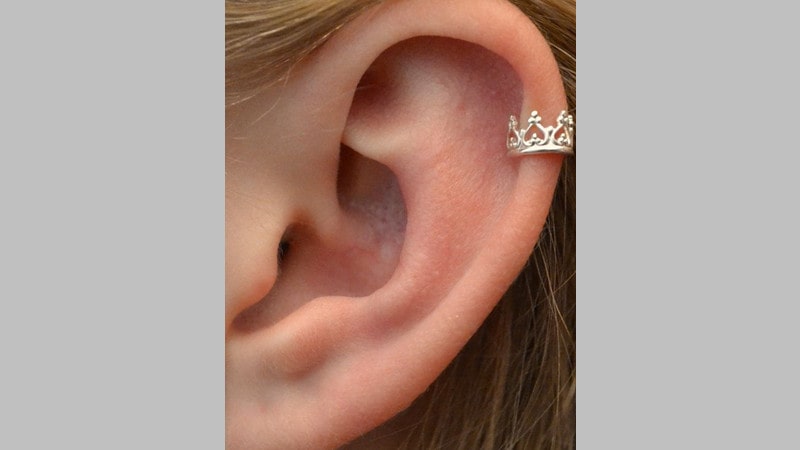
Image source: Pinterest
The Helix ear piercing is usually placed on the upper outer cartilage of your ear. However, different ear designers are now experimenting with different styles with this type of piercing. It’s usually the first choice when someone wants to try something different from the traditional lobe.
This is a super cute ear piercing that typically lands in the middle or on the edge of the ear. This part of the ear allows you to personalize the placement of your ear piercings, giving you a unique style.
Although this type of ear piercing is not very painful, you are likely to feel a pinch when the needled perforates your cartilage. But the burning sensation doesn’t last too long.
2. Daith
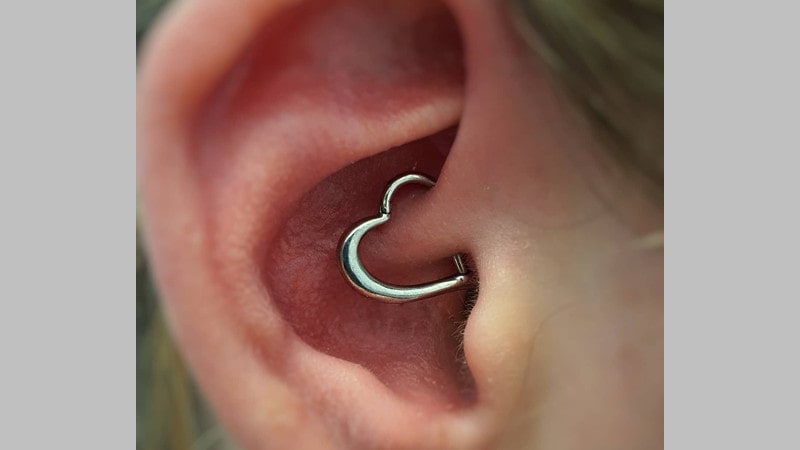
Image source: Pinterest
This is one of the most unique types of ear piercings because it is placed in a rather awkward position on your ear – the hoop that embraces your ear cartilage on the inner side of your ear.
The Daith ear piercing is quite tricky, and therefore it should be done by an experienced ear designer to avoid complications. Some people claim that this type of ear piercing helps to relieve migraines. But there’s no scientific proof of this claim.
The pain levels of Daith range between five and six out of 10 mainly because it is placed on the cartilage. This ear piercing takes between six and nine months to heal. You are encouraged not to sleep on the piercing until it heals to avoid infections.
3. Tragus
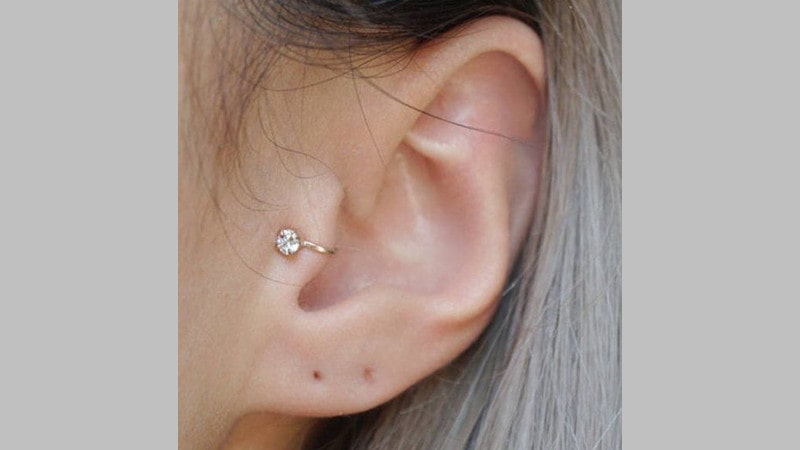
Image source: Pinterest
A tragus ear piercing lands on the tiny flap that partially covers your ear canal. This piercing adds more detail to your curated ears, especially when you decorate them with a sophisticated stud.
Since this piercing is done on the ear cartilage, its pain levels range between four and five out of 10. It also takes between six and nine months to heal completely.
4. Conch
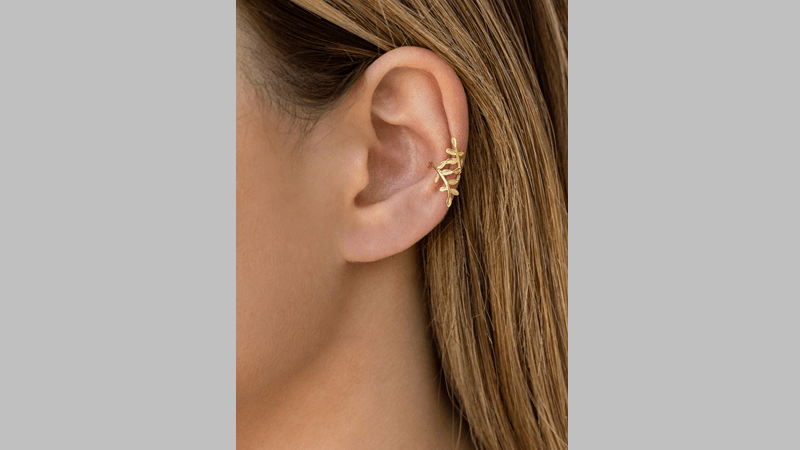
Image source: Pinterest
A Conch piercing is usually placed on the middle part of your ear cartilage. It acquires its name from the fact that it resembles the spiral shell commonly referred to as a conch. Its pain levels range between four and five out of 10. However, it heals faster than other cartilage piercings because it takes between three and six months.
5. Industrial
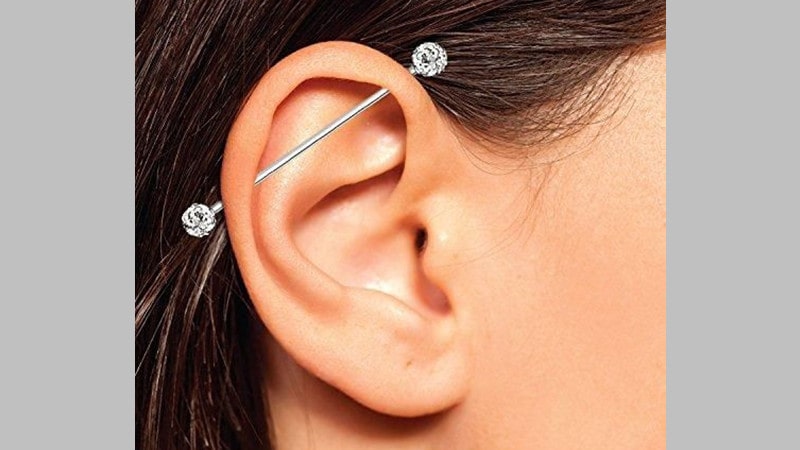
Image source: Pinterest
An industrial ear piercing is fairly new. It features a barbell connecting one cartilage piercing to another on your upper ear. This ear piercing takes longer to heal because it involves two piercings on one ear. The two piercings are susceptible to irritation because they are connected.
You shouldn’t sleep on your industrial ear piercing until it’s completely healed to avoid further irritation and infection. You should also expect the pain levels of this piercing to be higher than other piercings because it involves two piercings done simultaneously.
6. High-Lobe
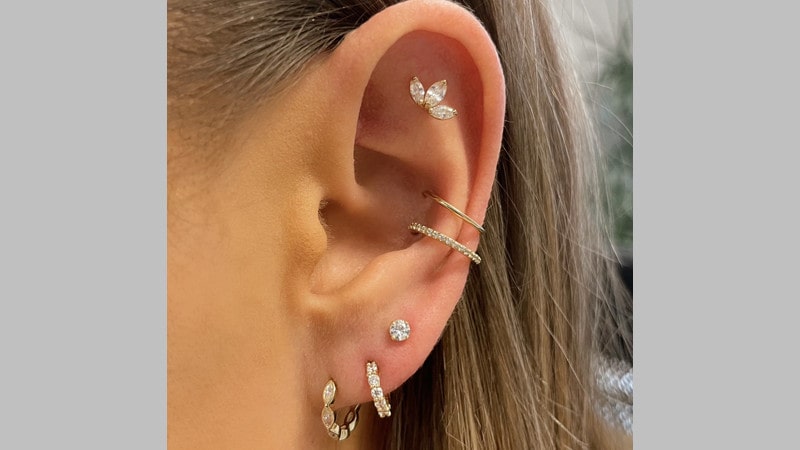
Image source: Pinterest
A high-lobe ear piercing is a simple way to spruce up your ear lobes. It also helps you to draw attention to any other poorly done piercing that you may have had before. Its pain levels are considerably low because the ear lobe is quite fleshy. This piercing takes between six and eight weeks to heal.
7. Rook
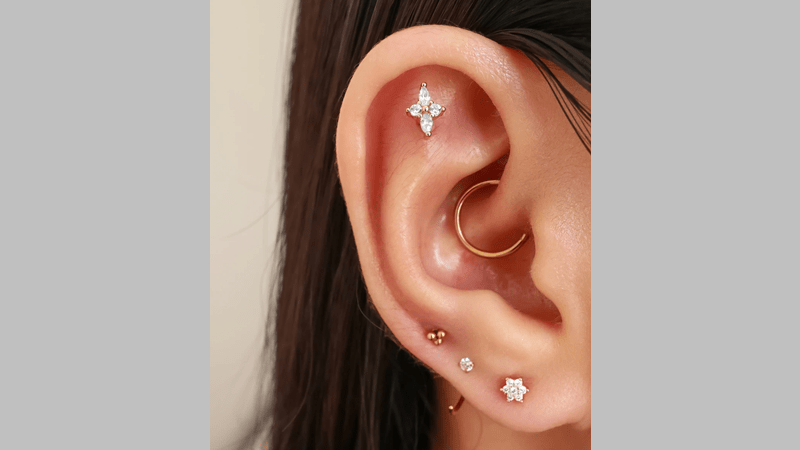
Image source: Pinterest
A Rook ear piercing is one of the most unusual types of ear piercings because it lands on the inner cartilage of your ear, just above the Daith and between the forward Helix and inner Conch.
It’s a bit painful because it doesn’t pierce easily, especially since the needle has to perforate the dense rook cartilage. This piercing takes between there and ten months to heal.
8. Standard Lobe Piercing
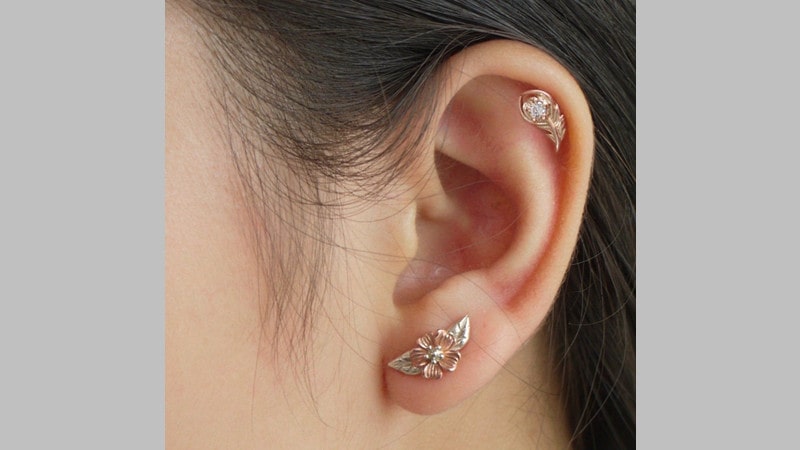
Image source: Pinterest
This is the traditional, standard lobe piercing. This lands on the ear lobe, which heals faster than any other part of the ear. It’s also less painful because the ear lobe has several layers of muscle. Lobe piercing takes about eight weeks to heal.
How to Take Care of Your Ear Piercings
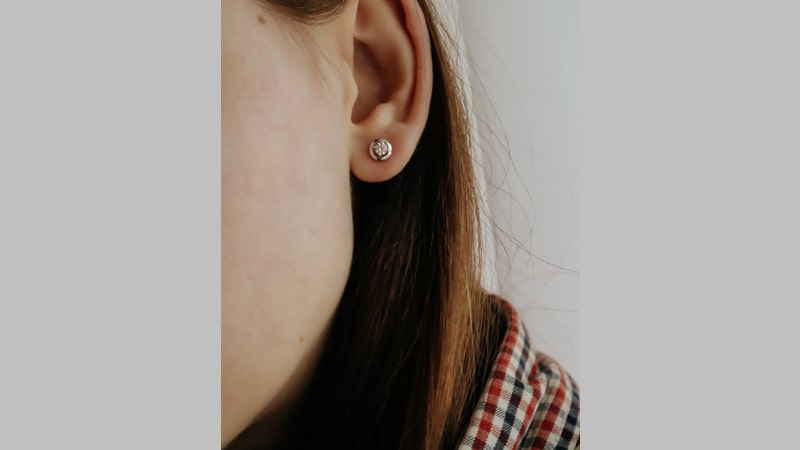
Getting your ears pierced is the easy part, but taking care of them until they are completely healed requires special attention. Sometimes you will be forced to sacrifice your sleep by sleeping in an uncomfortable position to avoid irritating your ear piercings. Here are some useful tips on how to take good care of your ear piercings.
1. Clean Your Hands Before Touching Your Ear Piercings
If you touch your ear piercings with dirty hands, you might contaminate the wounds, resulting in infections. So, avoid touching your ear piercing with dirty hands, especially when the wounds are still fresh.
2. Clean Your Ear Piercing with Soap and Water
You should clean your ears and ear piercings at least once a day with soap and water to get rid of germs that may have accumulated on the wounds during the day. Just remember to give your ears a little scrub when you are taking a shower.
3. Rub Your Ear Piercings with Alcohol
While soap and water will help you to get rid of germs from your ear piercings, sometimes you need to use something stronger like alcohol.
Rubbing your ears with alcohol helps to protect the sensitive skin around your ears against irritation and inflammation. It also helps to disinfect and remove extra germs that could be hiding in your piercings.
4. Clean the Studs
Although you are not supposed to disturb the starter studs until your ear piercings are healed, you should disinfect them routinely. Just rub some alcohol over the studs to remove germs and keep them clean.
5. Salt Water Soak
If your ear piercings are sensitive to harsh chemicals like soap and alcohol, you should clean them with saltwater. Gently wipe your ear lobes with salt water at least once a day. It will eliminate those nasty germs without being too harsh on your skin.







